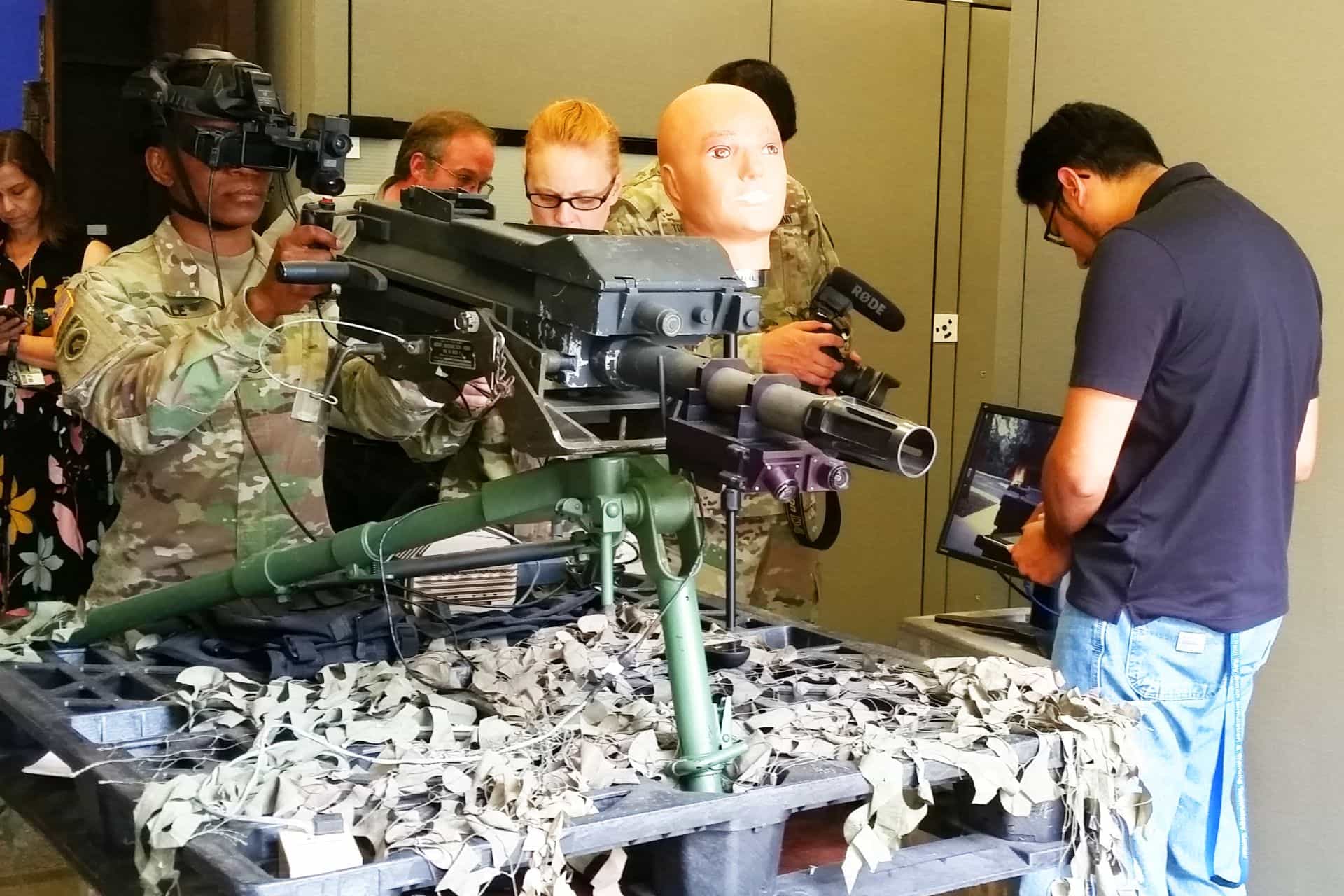Setting up a range day for training on the MK-19 grenade launcher is no easy task.
Researchers at the Army Research Laboratory-Orlando have an idea about how to change that, however, through the use of augmented reality.
To train on the MK-19 with real grenades “range cadre have to be available,” said Dean Reed, a software developer and team lead at ARL. “And it requires a very long training range. You need that long distance.”
Not so at ARL Orlando. There, they demonstrated that one might need only 25 meters to get Soldiers the practice they need on the MK-19.
“We use augmented reality. We’re just firing out into the parking lot,” he said. “It takes us under 30 minutes to set up the system.”
Instead of going to a range, getting range time and range cadre, as well as expensive rounds, the researchers at ARL Orlando have the MK-19 — augmented with computer hardware and a head-mounted display or HMD — pointed out into the employee parking lot out of a garage door at the rear of their facility.
The HMD is equipped with video cameras that stand in for a Soldier’s eyes. The goggles put LCD modules in front of the Soldier’s eyes, so they see what is coming in through the cameras. And with the augmented reality turned on, the computer system inserts synthetic elements, like enemy soldiers, into the vision.
Using a tablet computer, which the system runs on, operators can create a custom scenario for the Soldier to train on.
Putting on the headset that’s attached to the MK-19, Soldiers can look out into the parking lot behind the ARL facility and see the employee cars parked there. They see exactly what they’d see without the head-mounted display. When they turn their head, the image turns with them.
But then, a pickup truck rolls onto the scene. The truck is synthetic — generated by the tablet computer. The synthetic truck image is merged with what’s coming in from the cameras mounted on the HMD, before it’s put in front of the Soldier’s eyes. The truck appears to have actually driven into the lot. If the Soldier takes the HMD off, the truck is gone.
“These things will actually drive around appropriately on the trails that you give them,” Reed said of the synthetic elements the software can add as part of a training scenario.
The scenario also includes a truck driver and another individual standing outside the truck and milling about.
Wearing the HMD, A Soldier can look down at the MK-19 and see the weapon and the triggers. Looking up into the parking lot, he can also see an indicator projected into his vision, showing him where the grenade will likely land. The indicator moves when he moves the MK-19.
Firing the weapon, the Soldier can hear the computer-generated sounds of a round being fired. And if he’s on target, he can also see the enemy combatant fall, and the truck collapse to the ground and go up in flames and smoke.
ARL didn’t invent the MK-19, or the concept of augmented reality. But they did, at ARL Orlando, merge existing hardware together with software algorithms they wrote to create the MK-19 trainer.
Getting the computer to accurately merge the direction of the weapon, and the trajectory of the grenade into a simulation, and to create the correct visuals to project into a Soldier’s eyes to make it all seem real — that’s the big challenge for the researchers at ARL Orlando.
“It’s really the computer vision algorithms that merge the real world with the virtual world,” Reed said. “It’s kind of a mixed-reality system. That’s the hard bit, getting that orientation and realistic projection of those models, in the real world.”
Taken together, Reed says, he thinks the concepts proven by the MK-19 trainer at ARL Orlando are the future of training for Soldiers.
“The accessibility this gives you is dramatic,” he said. “You don’t have to go sign out the expensive equipment and have a whole organized day. Usually there are range officers involved and safety officers. Here, you can literally just go to the motor pool, open the high bay door and get tracking.”
In a real training environment, getting repetitions means getting more expensive rounds and reloading, and taking the range cold and then hot again in between. With the trainer, a reset can be done much more quickly.
“To reload this, it’s basically click on the tablet,” Reed said. “It clears the scenario, reloads it and you’re ready to go again. Normally you could rerun the same scenario within a minute.”
That short reset time means Soldiers can get as many repetitions on the weapon as needed before going out to the real range and firing the weapon for real. That means Soldiers get the confidence and skill they need for less money.
The MK-19 trainer is not quite ready for the field just yet. For now, Reed said, the HMD on the system needs to be improved. Indoors it’s good, he said. But outdoors, where it’s extremely bright and hot outside, it might not work.
“The HMD are not really bright enough to handle all the timing conditions that we are going to see,” he said.
But still, the MK-19 trainer demonstrates what’s possible with augmented reality training for the Army — and that’s the goal of ARL Orlando: to conceptualize what can be done and to prove it’s possible to achieve.










